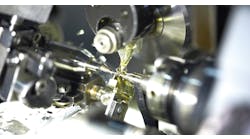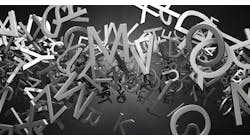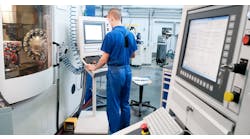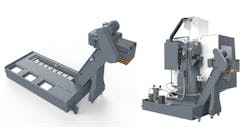Knowing more about Invar, a popular high-tech alloy material, can help shops boost production.
Both Invar alloys are commonly machined on automatic screw machines and CNC lathes like this one used by Carpenter Technology Corp. for machinability testing.
When using Invar alloys try these suggested geometries for single-point turning tools.
These are the suggested geometries for circular cutoff tools.
These are the suggested geometries for circular form tools used with Invar alloys.
Suggested geometries for drills deserve consideration.
Typical taps used on Invar alloys are shown with suggested geometries and grinding techniques.
Above are typical milling cutters, with suggested geometries.
Today's metalworking shops frequently machine parts and components from Invar alloy (UNS K93600), a 36% nickel-iron alloy known for its unique low-expansion properties. Although the material has been fairly popular for years, shops can still benefit from a better understanding of its machining parameters.
Produced by Carpenter Technology Corp., Reading, Pa., the alloy has a rate of thermal expansion approximately one tenth that of carbon steel at temperatures up to 400 8F (204 8C).
The alloy is available in two variations. One is the conventional Invar alloy, used generally for its optimum low-expansion properties. The second is a variation of the basic alloy known as Free-Cut Invar "36" alloy (UNS K93050 and ASTM F1684). This alloy has shown improved machinability for applications where high productivity is important. It is also a 36% nickel-iron alloy, but with a small addition of selenium to enhance machinability.
Free-machining variation
Free-Cut Invar "36" alloy, the first free-machining Invar alloy, is used by machine shops producing high volumes of parts like controls for hot water heaters, filters for microwave instruments, and precision parts for optical mounting in lenses.
Compared with the conventional Invar grade, the downside for Free-Cut Invar "36" alloy is negligible. Its coefficient of thermal expansion is slightly higher than that of the basic alloy, which is not enough to make a difference in part performance.
With the free-machining alloy, there is a minimal loss in both transverse toughness and corrosion resistance. It may be necessary to clean and passivate the free-cut alloy to remove selenides from the surface.
However, a good case can be made for the free-cut alloy because it machines without a hassle and often boosts production by as much as 250%.
Both Invar 36 alloys are soft like Type 304 and Type 316 austenitic stainless steels and have the same high workhardening rate, requiring care in machining. The free-cut variation, in particular, machines similar to the two stainless grades.
The standard Invar alloy produces stringy, gummy chips which "birdnest" around the tools and interfere with coolant flow. Chips have to be broken up using chipbreakers. Chipbreakers are also used with the free-cut alloy, but they do not have to be as deep as those used for the basic alloy because the free-cut chips are more brittle.
Large, sharp, and rigid tooling is recommended for both grades. A positive feedrate should be maintained for all machining operations to avoid glazed, workhardened surfaces. In some cases, increasing the feed and reducing the speed may be necessary. In addition, shops should avoid dwelling, interrupted cuts, or a succession of thin cuts.
In general, the free-cut Invar alloy produces a good surface finish and increases productivity. However, during all cutting operations, both materials require proper lubrication and cooling.
Machining parameters
There is no single set of rules or simple formula that is best for all machining situations. In addition to the materials used, job specifications and equipment must be considered in determining the most applicable machining parameters.
Operations such as turning on automatic screw machines, turret lathes, and CNC lathes involve so many variables that it is impossible to make specific recommendations which would apply to all conditions. So, the following parameters should serve only as a starting point for initial machine setup.
Turning
Properly ground tools are essential in turning Invar alloy. In addition, as large a tool as possible should be used to provide a greater heat sink, as well as a more rigid setup. The front clearance angle should also be minimized to ensure adequate support for the cutting edge.
Invar alloys require tools ground with positive top rake angles on the high side of the 5 8 to 10 8 range to control the chips. They may also require increased side-clearance angles to prevent rub-bing and localized workhardening.
Carbide tools in single-point turning operations will allow higher speeds than high-speed tool steels. However, carbide tooling requires even greater attention to rigidity of tooling and the workpiece. Interrupted cuts should be avoided.
Either blade-type or circular cutoff tools are used for Invar alloy applications. Blade-type cutoff tools usually have enough bevel for side clearance (3 8 minimum) but may need greater clearance for deep cuts. In addition, they should be ground to provide for top rake and front clearance.
The front clearance angle is 7 8 to 10 8. A similar angle should be used for the top rake, or a radius or shallow concavity may be ground instead. The end-cutting edge angle may range from less than 5 8 to 15 8, with the angle decreasing for larger-diameter stock.
Angles for circular cutoff tools are similar to those for blade-type, including a top rake angle of 7 8 to 10 8.
Since circular cutoff tools are more rigid than blade-type and can withstand more shock, they are preferred for automatic screw machine operations where they are fed into drilled or threaded holes. Because of their size, they also dissipate heat better.
While shops can use carbide-tipped cutoff tools, they should also consider the shock loading from interrupted cuts.
When turning Invar alloys with form-tools, shops need to keep in mind that speeds and feeds are influenced by the width of the tool in relation to the diameter of the bar, the amount of overhang, and the contour or shape of the tool. Generally, if the width of the form-tool exceeds 1.5 3 the diameter of the workpiece, chatter becomes a problem.
Dovetail form tools should be designed with a front clearance angle of 7 8 to 10 8 and ground with a front rake angle of 5 8 to 10 8.
Angles for circular form tools are similar. Higher rake angles within the 5 8 to 10 8 range may be used for roughing operations, while lower rake angles are more applicable for finishing.
Tooling side clearance or relief angles need to be 1 8 to 5 8 depending on depth of cut. This prevents rub-bing and localized heat buildup, particularly during rough forming. It may also be necessary to round corners. A finish form or shave tool may be necessary to obtain the final shape, especially for deep or intricate cuts.
Carbide-tipped tooling may also be used for forming operations as long as consideration is given to shock-loading from interrupted cuts.
Drilling
Certain rules need be to observed in drilling Invar alloys. For example, the workpiece must be kept clean and chips removed frequently to avoid drill dulling. In addition, drills must be carefully selected and correctly ground. Also, drills must be properly aligned and the work firmly supported.
Other requirements include directing a stream of cutting fluid at the hole. And, finally, drills should be chucked for the shortest drilling length to avoid whipping or flexing.
When working with Invar "36" alloy, it is advisable to use a sharp three-cornered punch rather than a prick-punch to avoid workhardening the material at the mark. Drilling templates or guides would also be useful.
To relieve chip packing and congestion, drills must occasionally be backed out. The general rule is to drill to a depth of three to four times the diameter of the drill for the first bite, one or two diameters for the second bite, and approximately one diameter for each of the sub-sequent bites.
Grinding a groove parallel to the cutting edge in the flute for chip clearance allows the drilling of deeper holes per bite, particularly with larger-size drills. The groove also breaks up the chip for easier removal.
Allowing the drill to dwell or ride during cutting glazes the bottom of the hole, making restarting difficult. Therefore, when relieving chip congestion, drills must be backed out quickly and reinserted at full speed.
While drill feed is important in determining the rate of production, carefully selecting proper feeds and speeds can increase both drill life and production between re-grinds.
Tapping
For open or through holes, shops can use either spiral-flute or straight-flute, spiral-pointed taps. Both provide adequate chip relief in tapping the relatively soft Invar alloys.
The spiral-pointed tap cuts with a shearing motion and has less resistance to the thrust. And, the entering angle deflects the chips so that they curl out ahead of the tap, preventing packing in the flutes. Also, when backing out a spiral-pointed tap, there is less danger of roughing the threads in the tapped hole.
Spiral-pointed taps should not be used in blind or closed holes unless there is sufficient untapped depth to accommodate the chips. In order to properly tap blind holes, special spiral-pointed bottoming taps are necessary. However, spiral-fluted taps with a spiral of the same hand as the thread can do the job, since they are designed to draw chips out of the hole.
Milling
Carbide inserts may be used for both Invar grades.
As a general rule, the finest finishes are obtained with helical or spiral cutters running at high speed, particularly for cuts over 19-mm (0.76 in.) wide.
Helical cutters cut more freely and with less chatter than straight-tooth cutters. Coarse-tooth or heavy-duty cutters work under less stress, permitting higher speeds than fine-tooth or light-duty cutters. They also have more space between the teeth to aid in chip disposal.
For heavy, plain milling work, a heavy-duty cutter with a faster, 45 8 left-hand spiral is preferred. The higher angle lets more teeth contact the work at the same time, thereby reducing chatter.
Invar - a legend in metals
Free-cut Invar 36 alloy improves the machinability of these shafts used for water heater controls.
The low expansion alloy known as Invar has been around for some time. In fact, 1996 marked the centennial of its discovery.
This alloy has been so important to scientific advancement that it earned the Nobel Prize in 1920 for its inventor, Charles-Edouard Guillaume, the first and only scientist in history to be so honored for a metallurgical achievement.
Invar has developed into a family of low expansion, nickel-iron alloys including Free-Cut Invar "36" alloy, a variation of the original material with improved machinability. Both grades contain 36% nickel, key to achieving a low coefficient of expansion, and both continue as the most commonly used alloys in the group.
These two alloys, along with the other Invar grades, have been used in a wide variety of both common-place and high technology applications. Commercial uses have proliferated over the years in fields as diverse as semiconductors, television, information technology, aerospace, and cryogenic transport. Invar has been used in a host of applications. Early uses include light bulbs and electronic vacuum tubes for radios; bimetals in ther-mostats for temperature control; lead-in seals of fluorescent lights; measuring devices for testing gages and machine parts; military and electronics applications where expansion control is critical; bimetals for circuit breakers, motor controls, TV temperature compensating springs, appliances and heaters, aerospace and automotive controls, heating and air conditioning, as well as many others.
With ever-increasing vigor, this 102 year old alloy continues to expand in usage, with newer applications like more sophisticated thermostatic controls, containers used to transport cryogenic liquid natural gas in tankers, shadow masks in high-definition television tubes, structural components in precision laser and optical measuring systems, wave guide tubes, microscopes, supports for giant mirrors in telescopes and scientific instruments requiring mounted lenses, composite molds used in building new generation aircraft, and in a range of scientific applications such as orbiting satellites, lasers, and ring-laser gyroscopes.





